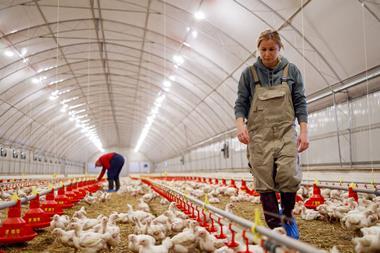There is so much to think about as you plan for re-opening your foodservice/hospitality business once the lockdown restrictions begin to be lifted. And judging by my conversations with operators, supply chain is quite low down the list of priorities.
After all, you had a supply chain when you closed your doors. Surely, it is just a case of placing new orders to stock up, and off we go! Well, maybe…
Will anything have changed compared to pre-lockdown?
The wholesale supply community that services our sector has had much the same experience as operators. Many report revenues of less than 10% of 2019 levels. The hundreds of manufacturers and growers that sit behind our wholesalers and have been central to our success have been under similar financial stress. Whilst many will survive and continue to be financially strong, sadly others may already have failed, and many more may be at significant risk of collapse. If you haven’t paid your February/early March invoices yet, then expect to be behind those who have, in the queue for product. Credit terms will likely be tightened, especially for operators with a weak balance sheet. Cash will have a new level of importance in a way that was not present immediately pre-pandemic.
Staff are furloughed at every level in the supply chain, (not just hospitality) and in many cases assets have been diverted to create returns from other activities such as supplying supermarkets or delivering to consumers direct. Shift patterns of workers and delivery schedules will need to be redeveloped as demand starts to return and will continue to evolve as the industry recovers.
It is also unlikely that you will resume trading either on the same ingredient mix, and at the same volumes as you did immediately before the closure took effect. Wholesalers rely upon historic data to help them manage their own forward ordering, but in a world where there are so many uncertainties it is likely that there will be significant shortages in many categories of product, particularly for very tight specifications – at least for a while.
Supermarket sales volumes in March were 10.4% up on pre-lockdown levels - a record spurt of growth for grocers - while alcohol-focused stores enjoyed a jump of 31.4%. And that’s without online sales which also surged ahead. Indeed, total online revenues reached a record share of all retail spending at 22.3% during March as stores closed and consumers ventured outside less.
Lockdown measures in many countries around the world are likely to have some impact on the overall output of food production over the coming months, which with the UK importing 50% of our food and drink could also impact availability on imported products.
The upstream supply of food has now adjusted to the vast majority of fresh and chilled supply heading for retail channels, and a readjustment to our sector will need careful management.
In the same way as the retailers struggled to get product on the shelves in the immediate aftermath of the closure of pubs, restaurants and cafes, so to will foodservice suppliers have a big challenge on their hands in the first few weeks post opening.
What should I do whilst I am still unclear when we will re-open?
There is quite a lot you can do, even before you know when you will re-open. Keep dialogue going with your suppliers. Understand how the pandemic is impacting your key suppliers. Are they at risk? Are they keeping in touch with their own suppliers and are there any products at risk? How well are they managing the crisis? What do they need to know to create maximum availability from day one of re-opening? What notice is required for first orders? Have they diverted capacity elsewhere?
Discuss your suppliers trading position, particularly regarding cashflow and any debt. Have you paid your February and March invoices? If you have an agreement with your supplier check for mutual understanding of the status of the contract, particularly regarding the term of the agreement, and rebated discounts or volume targets. Agree the criteria for payment. What kind of credit risk does the supplier view your business as? What expectation is there regarding pricing post lockdown? Keep suppliers informed of your progress with management of the pandemic, and your plans for the future. Ensure regular updates to gain an understanding of your suppliers plans to recommence supply with the sector as they will be in constant discussion with their other customers and this could also play part of determining what is possible to support your own supply plans and timing.
Consider the re-stock order particularly carefully. Your initial orders will be larger than subsequent ones, as you seek to replenish ongoing stocks, particularly on long shelf-life products. Make sure that you share your needs at a line level with your suppliers – the lead time to re-opening may be shorter than you expect, and this will enable your supplier to plan for your needs well in advance. Providing regular forecast updates to suppliers will also be critical as demand and volumes will be evolving after the restart and there will be a fine balance between ensuring continuous availability and tying up too much cash in stock.
Monitor key suppler stability. Check the supplier’s (and upstream manufacturer’s) most recently published balance sheet and trading accounts on Companies House. Grade suppliers based upon their criticality to your business and the strength of their finances - and create an “at risk” register.
Create contingency plans. Where product is both critical and has a high level of risk create a contingency plan that would create availability in the event of a sudden supply failure.
Consider menu tightening. Create a list of products that you feel may be at risk and consider if specifications can be loosened or products eliminated for the time being.
When re-opening, planning and communication are key
Contact suppliers and discuss ranging and ensure stock availability, discuss and reconfirm delivery, agree prices and (critically) payment plans. Discuss and agree contingency processes for larger/smaller volumes than planned.
Place orders as early as possible, don’t wait until the last minute.
Agree specific contingency plans for non-availability. Will you accept substitutes? If so, what is acceptable/not acceptable? What level of shorts could you accept?
Make a record of any supply issues you have – delivery times, product availability, and product quality.
Once you open your doors speak with suppliers regularly, and maintain a constructive dialogue to resolve the inevitable issues in the early days following opening.
The key to success will be communication. This will not be a time to simply place an order and hope it will turn up in full!
Precis
INISIGHT
David Read: A new era of supply
There is so much to think about as you plan for re-opening your hospitality business once the lockdown restrictions begin to be lifted. And judging by my conversations with operators, supply chain is quite low down the list of priorities. After all, you had a supply chain when you closed your doors. Surely, it is just a case of placing new orders to stock up, and off we go? Well, maybe.




































